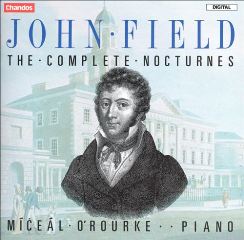John Field – The Complete Nocturnes (1989)
John Field – The Complete Nocturnes (1989)

CD1 1. No.1 in E flat major--Molto moderato 2. No.2 in C minor--Moderato e molto espressivo 3. No.3 in A flat major--Un poco Allegretto 4. No.4 in A major--Poco Adagio 5. No.5 in B flat major--Cantabile, assai Lento 6. No.6 in F major, Cradle Song--Andante tranquillo 7. No.7 in C major, Reverie-Nocturne--Dreamily 8. No.8 in A major--Andante 9. No.9 in E flat major--Andante spiananto CD2 1. No.10 in E minor--Adagio 2. No.11 in E flat major--Moderato 3. No.12 in G major--Lento 4. No.13 in D minor, Song without Words--Lento 5. No.14 in C major--Molto moderato 6. No.15 in C major--Molto moderato 7. No.16 in F major--Molto moderato 8. No.17 in E major, Nocturne Pastorale--Andante con moto 9. No.18 in E major, Nocturne characteristique 'Midi'—Allegro Miceal O’Rourke – piano
John Field is probably one of the most under-rated composers . Most classical music afficianados swoon over Chopin's nocturnes (justifiably so) , but I am surprised by the number of people who have never even heard of Field !Unlike Chopin , John Field does not wear his heart on his sleeve in these nocturnes , but to my mind they are far more superior .They are delicate & delectable without being maudlin (unlike Chopin)...listening to these nocturnes at night is like watching snowflakes fall on an arctic lake in the comfort of a heated cabin !If you like Chopin's nocturnes , you'll love these hidden gems ! ---W. Khan, amazon.com
John Field, (born July 26, 1782, Dublin—died Jan. 23, 1837, Moscow), Irish pianist and composer, whose nocturnes for piano were among models used by Chopin.
Field first studied music at home with his father and grandfather and afterward in London with Muzio Clementi, under whose tuition, given in return for Field’s services as a piano demonstrator and salesman, the boy made rapid progress. In 1802 Clementi took Field to Paris and later to Germany and Russia. Field quickly secured recognition as a pianist and composer and in 1803 settled in Russia, becoming for a time a popular and fashionable teacher. He played extensively throughout Europe during the next 30 years and had great success with one of his E flat piano concerti at a Philharmonic Society concert in London in 1832. He is credited with being one of the earliest to develop the use of the sustaining pedal, both in the prescription of it for his music and in his own performance.
Field was one of the earliest of the purely piano virtuosos, and his style and technique strikingly anticipated those of Chopin. As a composer he was at his best in shorter pieces, where his expressive melodies and his imaginative harmonies, often chromatic, are not exposed to the strain of long development. Field wrote seven piano concerti and four sonatas, in which high quality is often apparent but not consistently maintained. In the nocturnes, more concise and intimate than his larger works, Field’s music is distinguished in style and varied in mood. --- britannica.com
Last Updated (Friday, 07 August 2015 21:12)








